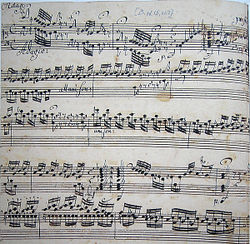Toccata
Toccata is the title that was often given to pieces of music for solo instruments from the Renaissance onwards. The word comes from the Italian for to touch, also meaning to play a musical instrument. These pieces were often quite difficult, with a lot of fast notes which showed off how well the person could play.
The first toccatas were written in northern Italy by composers such as Claudio Monteverdi and Giovanni Gabrieli. They are pieces for the keyboard (harpsichord or organ) with lots of running scales in the right hand and accompanying chords in the left hand.
Toccatas became popular in Germany with composers such as Hans Leo Hassler who had studied in Venice with Gabrieli. Many German Baroque organ composers wrote toccatas: Sweelinck (who was Dutch), Pachelbel, Buxtehude and Johann Sebastian Bach. Bach wrote a Toccata and Fugue in D minor, which is one of the most famous pieces of Baroque organ music, and perhaps the most famous toccata ever written.
After the Baroque period composers did not often write toccatas. The toccata became popular again in the late 19th century with the French organ composers such as Charles-Marie Widor whose Toccata from his Symphony No. 5 is very popular today, especially at weddings. It has lots of quick notes in the right hand (and occasionally in the left) and a big tune in the pedals. Another famous organ toccata is by Louis Vierne. It is the last movement of his Symphony No. 1 (at this time French composers wrote organ works called "symphonies").
In the 20th century several composers wrote toccatas for piano including Prokofiev, Khachaturian, Ravel (part of Le Tombeau de Couperin) and Claude Debussy (part of Suite: Pour le Piano).
Toccata Media
The first page of J.S. Bach's Toccata and Fugue in D minor, BWV 565
